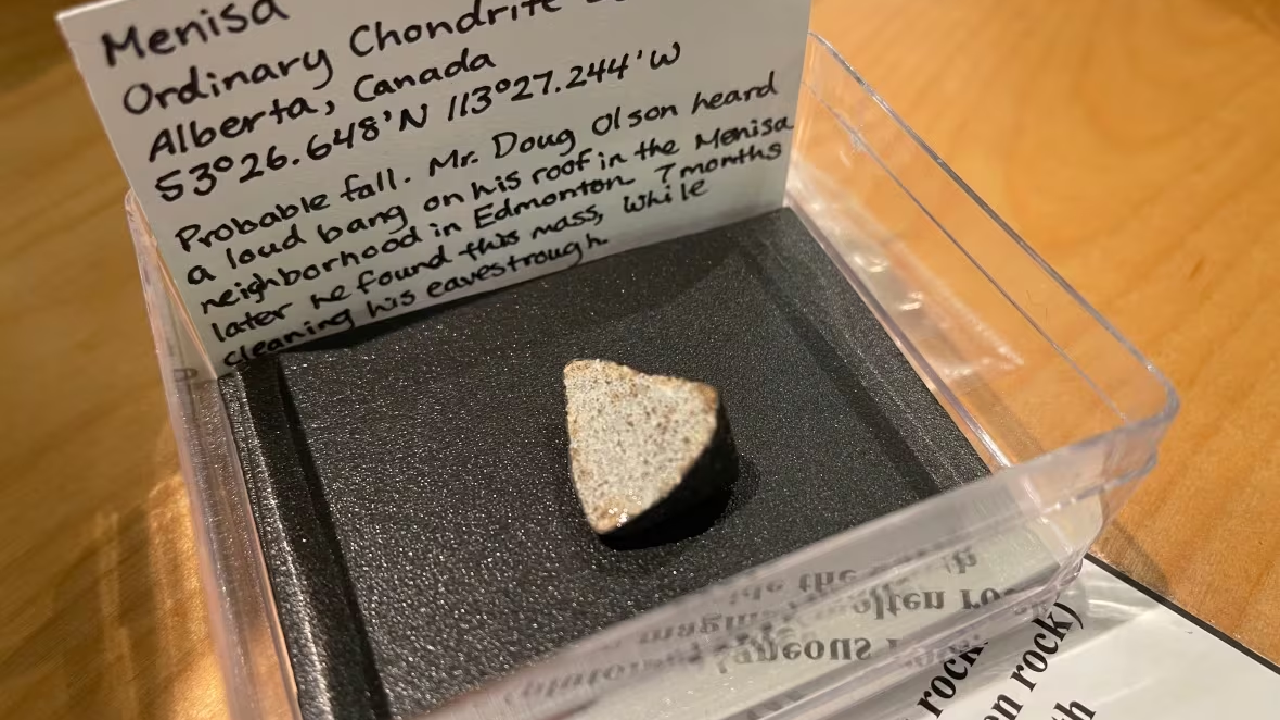In an unexpected turn of events, Doug Olson of Mill Woods, Edmonton, stumbled upon a small meteorite while cleaning out his rain gutters this spring, marking the first witnessed fall of a meteorite in Alberta since 1977, reported CBC. The Menisa meteorite, as it is now named, weighs 33 grams and is only the 18th ever found in the province, according to the University of Alberta.
The discovery began when Olson heard a loud thud on his roof while folding laundry in October last year. At that time, his investigation yielded nothing out of the ordinary. However, while clearing out his rain gutters this spring, Olson found the small grey and black rock that turned out to be a celestial visitor from space.
“I was thinking, ‘jeez how come I couldn’t find it back when I was looking the first time?'” Olson remarked on Friday.
Olson, known as the “meteorite guy” at his local coffee shop, has a history of meteorite hunting. He had previously contacted the University of Alberta’s Department of Earth and Atmospheric Sciences after discovering what he believed to be another meteorite in Fort McMurray years ago.
The Menisa meteorite contains metal made of iron and nickel, along with a grey material called chondrule, commonly found in meteorites composed of various minerals, according to Chris Herd, a meteorite expert at the University of Alberta. Herd emphasized the rarity of this particular meteorite, stating that while small asteroid fragments frequently fall from space, the Menisa meteorite’s unique characteristics make it a rare find.
“There’s a bunch of stuff that’s making its way around the solar system all the time, different sizes. We think we know where the biggest stuff is that might threaten us. The small stuff is a complete surprise,” Herd explained. “It’s just luck that it happened in this way.”
A portion of the Menisa meteorite is now part of the University of Alberta’s meteorite collection, which is the largest university-based collection in Canada. Olson has been allowed to keep the remainder of the meteorite.
Herd highlighted that Alberta’s clear skies and extensive farmland increase the likelihood of finding meteorites on the ground. “We have lots of open spaces, and we’re also more northern, so it sort of increases the chances of meteorites being found on the ground on open fields,” he said. While the Menisa meteorite is not currently on display at the university, Herd confirmed that it will be showcased soon.
The discovery began when Olson heard a loud thud on his roof while folding laundry in October last year. At that time, his investigation yielded nothing out of the ordinary. However, while clearing out his rain gutters this spring, Olson found the small grey and black rock that turned out to be a celestial visitor from space.
“I was thinking, ‘jeez how come I couldn’t find it back when I was looking the first time?'” Olson remarked on Friday.
Olson, known as the “meteorite guy” at his local coffee shop, has a history of meteorite hunting. He had previously contacted the University of Alberta’s Department of Earth and Atmospheric Sciences after discovering what he believed to be another meteorite in Fort McMurray years ago.
The Menisa meteorite contains metal made of iron and nickel, along with a grey material called chondrule, commonly found in meteorites composed of various minerals, according to Chris Herd, a meteorite expert at the University of Alberta. Herd emphasized the rarity of this particular meteorite, stating that while small asteroid fragments frequently fall from space, the Menisa meteorite’s unique characteristics make it a rare find.
“There’s a bunch of stuff that’s making its way around the solar system all the time, different sizes. We think we know where the biggest stuff is that might threaten us. The small stuff is a complete surprise,” Herd explained. “It’s just luck that it happened in this way.”
A portion of the Menisa meteorite is now part of the University of Alberta’s meteorite collection, which is the largest university-based collection in Canada. Olson has been allowed to keep the remainder of the meteorite.
Herd highlighted that Alberta’s clear skies and extensive farmland increase the likelihood of finding meteorites on the ground. “We have lots of open spaces, and we’re also more northern, so it sort of increases the chances of meteorites being found on the ground on open fields,” he said. While the Menisa meteorite is not currently on display at the university, Herd confirmed that it will be showcased soon.
Denial of responsibility! Swift Telecast is an automatic aggregator of the all world’s media. In each content, the hyperlink to the primary source is specified. All trademarks belong to their rightful owners, all materials to their authors. If you are the owner of the content and do not want us to publish your materials, please contact us by email – swifttelecast.com. The content will be deleted within 24 hours.


